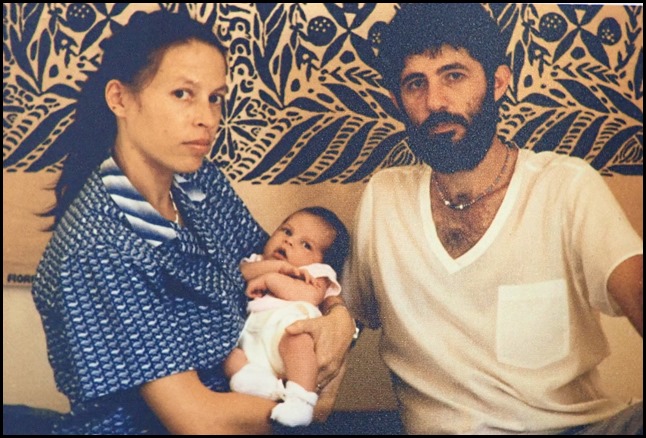DM History of Isishweshwe

Beez Neez now Chy Whella
Big Bear and Pepe Millard
Fri 10 Jan 2020 23:17
|
The History of a Material called
Isishweshwe 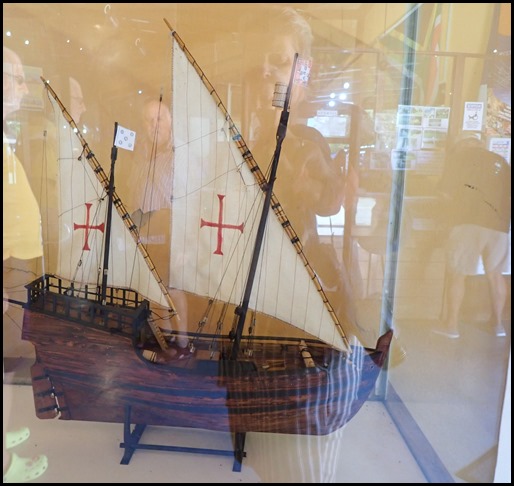 The model of the
Caravel Bartholomeu Dias in the
Granary Building where we entered the Dias Museum Complex. In the reflection –
Bear, Crocs bottom left, Larry, me, and Allen at the pay desk. This blog is
about the history of a material called isishweshwe, it will be of
little interest to most but it is written for my sister-in-law, Cecily who is
the Queen of the Sewing Machine, making gorgeous quilts and patchwork
masterpieces. The display was an interesting look at South Africa from a social
angle whilst looking at the material through the ages, as soon as I saw all the
old pictures I was hooked.
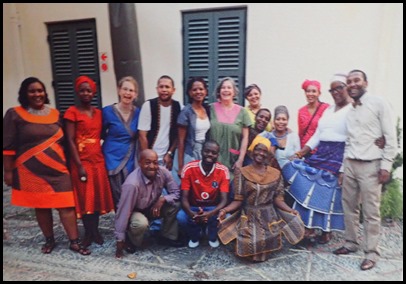 The team who put
the display together.
This travelling exhibition on the
origins of isishweshwe has been developed by Iziko Museums of South Africa for
Museum Services, Western Cape Department of Cultural Affairs and Sport. It is
based on the exhibition The Isishweshwe Story:material women? designed by the
Iziko Social History Department and made possible by the donation of a large
collection of isishweshwe and related artifacts, as well as images by Dr
Juliette Leeb-du Toit.
What is isishweshwe? Isishweshwe is a
sturdy, resist- or discharge-printed cotton fabric with regularly spaced, small
patterns, widely used in southern Africa for women’s, and increasingly men’s
clothing. It was introduced as blue print from Europe to southern Africa in the
19th century by missionary traders, and became a marker of colonial influence
and Christianity amongst indigenous women. Today it is a much-loved African
textile tradition, regarded as a national fabric in many southern African
countries, enjoying unique importance in the history of culture, dress and
fashion.
The term isishweshwe is derived from
the Sesotho word seshoeshoe (pronounced “seshweshwe”), as King Moshoeshoe I is
said to have condoned the use of European blue print from the Paris Evangelical
Mission Society in the mid-1830s. In the Eastern Cape people use isiXhosa names
derived from the word “German” to describe it: amajamani, ujamani, jelmani or
jereman. The Badepi call it motoishi, a Sepedi variant of the Afrikaans or
German word for German (Duits or Deutsch). It is also known as Duitse sis and
German print.
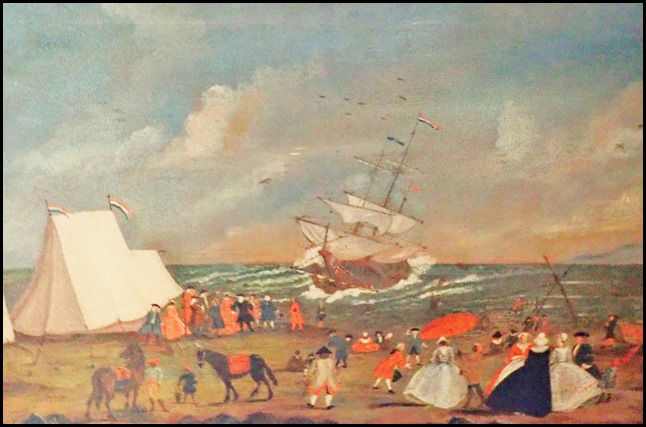 The Wreck of the
Visch at Camps Bay by J. Leeuwenberg. Oil
painting. 1740. Image courtesy of the National Library of South Africa (Cape
Town). Note the blue and white chintz dress on the
right.
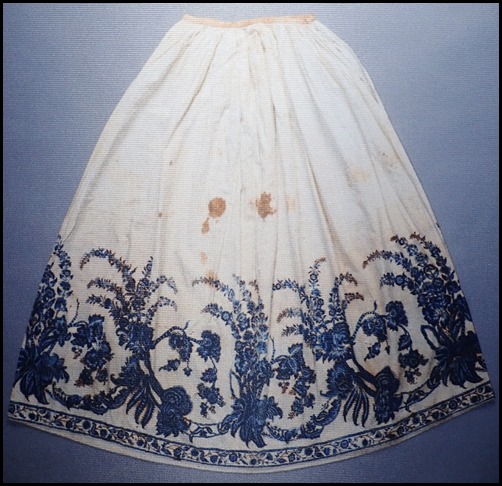 Petticoat of Indian chintz (Indienne), with a border design
in various shades of indigo. Probably Coromandel Coast, India, c. 1775-80.
Presented by Marianne Pfeiffer, Iziko Soc Hist. (Photograph:Carina
Beyer).
Blue print, isishweshwe’s precursor:
Sea routes opened by the Portuguese, Dutch and British during the 16th and 17th
centuries led to European domination of the Indian Ocean trade routes and new
colonial settlements. This opened massive trade possibilities for Europe,
including imports of multi-coloured Indian cottons known as calico, chintz, or
Indiennes, hitherto unknown to most Europeans. These sought-after fabrics were
hand-made, using natural dyes of which indigo blue was amongst the most
significant.
As they discovered the Eastern secrets
of colouring calicoes using resist pastes and carved woodblocks, Europeans
started copying these techniques at home. To cut costs, they imported only raw
materials not available in Europe, such as cotton and indigo.
Blue print, using indigo only, was
being hand-produced by small “blue-printers” in villages all over Central Europe
by the early 1800s. By the mid-1800s the process had been mechanised in the
industrial centres of Europe and Britain using the discharge technique, which
imitated the hand-made, resist-dyed blue prints. Factories sprang up around
towns such as Manchester (England), and many joined the Calico Printers’
Association.
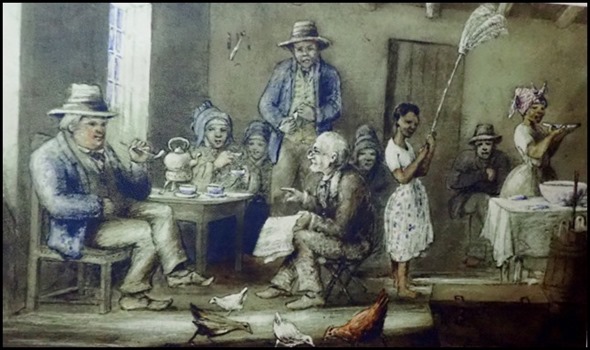 The
Schoolmaster Reading De Zuid-Afrikaan, by Charles Davidson Bell
(1813-1882). Watercolour, 1850. Note the blue and white skirt worn by the
servant holding the ostrich feather fan, (Iziko William Fehr
Collection).
Blue Print at the Cape: The Dutch
established the settlement at the Cape as a halfway station on the sea route to
the East. From the late 1600s it absorbed quantities of the Asian exports bound
for Europe, including indigo and Indian calicoes, which were used for clothing,
curtains and bed drapes. Indigo blue cloth also came to characterise the dress
of slaves, whether plain or patterned.
By the early 19th century,
German Morovian missionaries and their converts, such as those at Genadendal,
wore blue print, known by the German name of blaudruck. Many Germans
came to what is now KwaZulu-Natal and the Eastern Cape in the mid-1800s,
settling as artisans, Lutheran missionaries or farmers. For working dress, and
as evidence of their homeland Protestant identity, many wore
blaudruck.
Boer women also
adopted the fabric on farms and in small rural towns, and appreciated it for its
quality and strength.
A changing tradition: As European
powers penetrated deeper into southern Africa, and missionaries arrived to
spread Christianity in the 19th century, they encouraged woman to cover their
bodies with European-manufactured cloth, including blue print. This fabric, the
predecessor of isishweshwe, resonated with Africans, and they began to merge the
new fashion into their cultural practices, a creative process that continues to
this day. Isishweshwe continues to have many cultural applications in southern
Africa, especially amongst women, and can be seen as a marker of southern
African cultural identity.
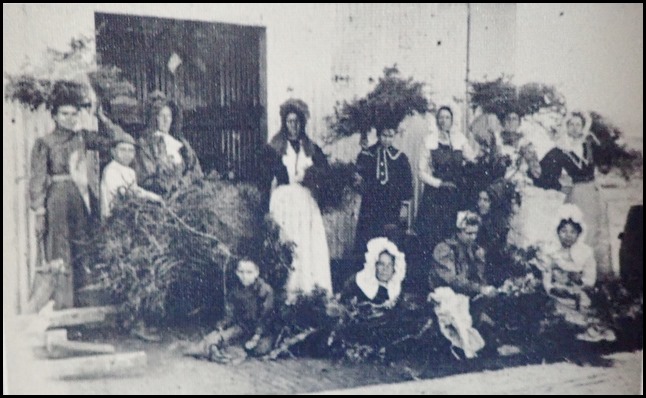 Members of the
Steyl family in a Boer concentration camp during the South African War.
Near Bloemfontein, 1899-1902. (Image courtesy Free State Provincial Archives).
Note the blue print bonnet (kappie) of the seated woman second from the
right.
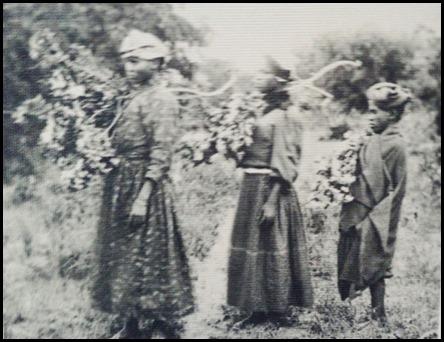 Women collecting
wood. Eastern Cape, late 19th century? (Image courtesy Nelson Mandela
Metropolitan Library Service).
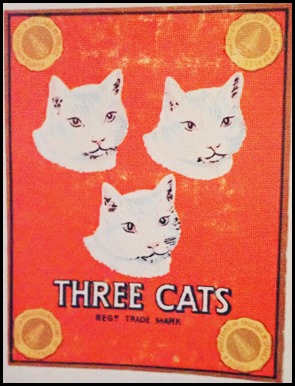 Blue Print becomes Isishweshwe: At
first, during the 19th century, the best quality mass produced discharged prints
were imported to South Africa from Germany. However, British factories had
cornered the market by the second decade of the 1900s.
In 1948 the British-based Calico
Printers Association established the Good Hope Textile Corporation in South
Africa with encouragement from the South African government. The company was set
up in a specially created village – Zwelitsha, near King William's Town – to
facilitate company access to cheap labour.
In the 1960s, trading as Da Gama
Textiles, the Corporation started making discharge-prints under the “Three
Leopards” logo, and by the late 1980s/early 1900s obtained the copyright for a
range of British designs with the “Three Cats” logo.
In South Africa the fabric had been
known in the vernacular as isishweshwe since the 1980s, and today Da Gama
Textiles is the world’s only manufacturer of what is known as “genuine
isishweshwe,” i.e., fabric produced using the discharge-printing
method.
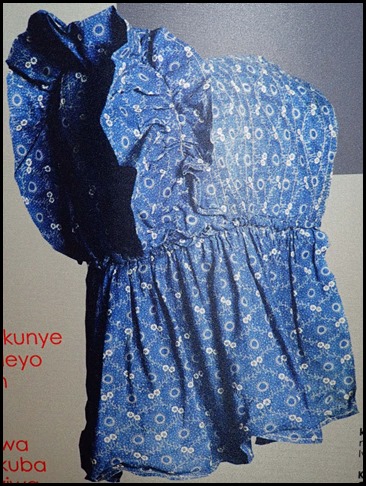 Bonnet
(kappie), machine-quilted, donated to the Amathole Museum in King
William’s Town, Eastern Cape by Rina van Graan. Probably early 1900s. From the
collection of the Amathole Museum (Photograph: Carina Beyer).
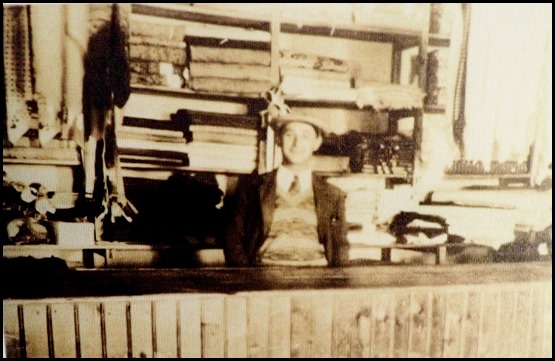 Shop assistant
Oscar Marcus in Solomon Fein’s shop in Concordia, Namaqualand, Northern
Cape c.1930. (Morris Boiskin Namaqualand Collection, Special Collections,
University of Cape Town Libraries.) Jewish shops selling their wares, including
fabrics such as isishweshwe, were dotted all over South Africa. Many Jews also
made a living as itinerant traders (smouse), peddling wares such as
isishweshwe.
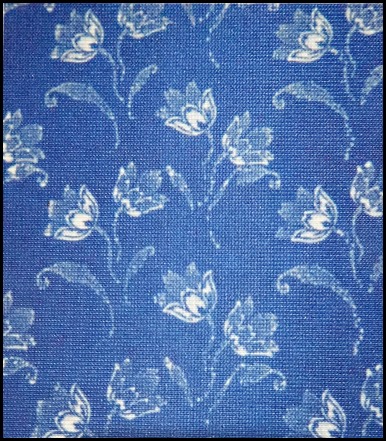 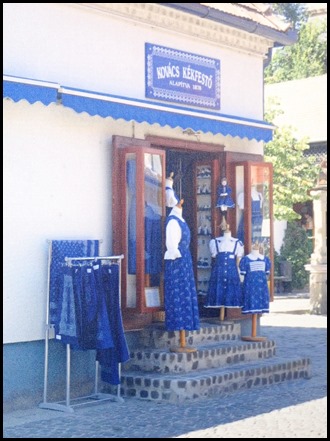 Blue Print in Europe Today: Originally worn
as peasant and work-wear in countries such as the Netherlands, Germany, Austria,
Czechoslovakia and Hungary, blue print became associated with European regional
and Protestant costume, and was often used to express nationalist sentiments.
Blue print in Europe today is worn in a context of nostalgia and as folk
costume.
Produced and used
in many rural regions in Germany, blaudruck became associated with volkisch
thought and national socialism in the years before World War II. Hungarian
kekfesto continues as daily dress in some rural communities, while it also
features in Hungarian regional dress. It has signaled a patriotic love for the
country since the peasant revolts of 1844. Dutch blaudruck, worn in the past by
workers, is now used to accessorise some regional costumes, used for items such
as head cloths and aprons.
A shop selling
blue print (kekfesto) in Szentendre, near Budapest, Hungary, 2006.
(Photograph: Kirsten Nieser). Besides being worn by labourers; as part of a
rural tradition; or (later) as a sign of nationalism, kekfesto coud also signify
“Christian wear”. bereavement and festive wear. A parallel South African use may
be found among widows in many African independent churches who wear isishweshwe
for the period of mourning.
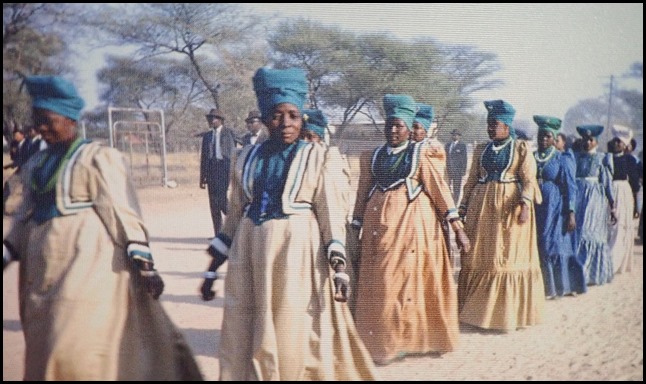 Marching Mbanderu
women in Okahandja on Herero Day, 26th of August 1960. (Image courtesy of
National Archives of Namibia/Zambik Collection). In Namibia and Botswanna,
Herero women copied Victorian era dresses and adopted blaudruck (blue print) and
other cloths worn by German settler women.
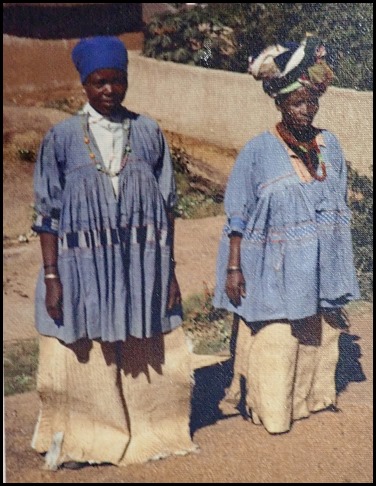 Bapedi women
wearing smocks, Phokwane Limpopo, 1973 (Photograph: John
Kramer).
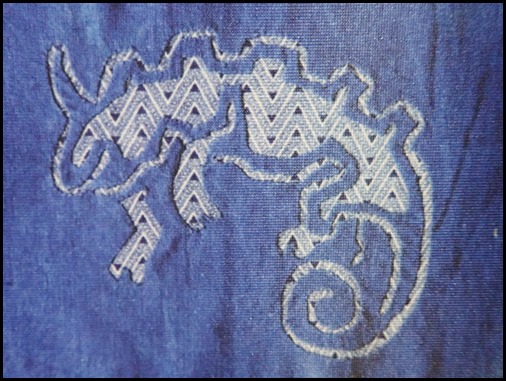 Reverse applique
motif of a chameleon, designed and made by Marie Peacey, 1980s.
(Photograph: Carina Beyer).
Isishweshwe for
social statements, solidarity and sewing: During the 1970s and 1980s many white
South African women wore isishweshwe to signal solidarity with the
anti-Apartheid struggle, or to convey their desire to be part of an alternative
culture. Needleworkers also liked to use it for applique and patchwork when
making items such as quilts and jackets.
Today community initiatives which
encourage the development of sewing skills to generate income often use
isishweshwe. The fabric is also a popular choice for making accessories and home
decorations, as well as souvenirs destined for the international market. The
wearer or user of such items at the same time stakes a symbolic claim to a
southern African tradition.
Beth and Desmond
Smart announce their firstborn, Rebecca Joy. Durban, KwaZulu-Natal, 1986.
(Photograph: Desmond Smart). Beth’s dress was made by a family friend, Mary
Butlin, who was a professional dressmaker working in Hillbrow at the
time.
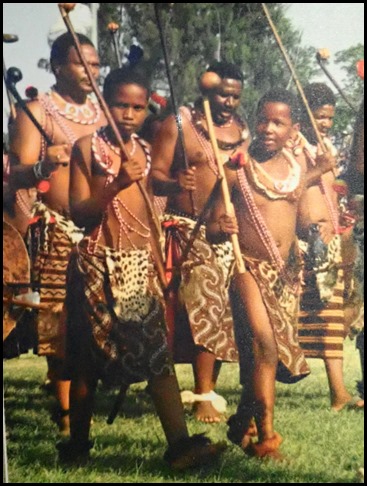 An emaSwati
amabutho group wearing sidvashi (skirts) with libululu (snake pattern)
design and amajobo (loin skins), at Swazi King Mswati III’s birthday
celebrations. Manzini, Swaziland, 2005. (Photograph: Kirsten Nieser). In
southern Africa isishweshwe is traditionally associated with women’s dress,
though in Swaziland and Lesotho it has been worn by men for cultural display.
The libululu design is the King’s favourite.
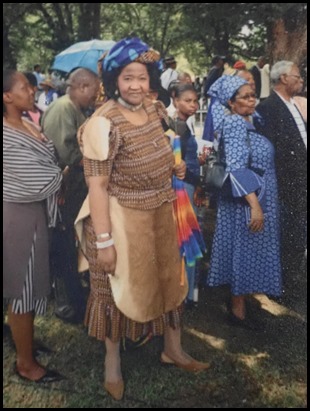 Unidentified women
attending Moshoeshoe I Day celebrations. Maseru, Lesotho, 2008.
(Photograph: Juliette Leeb-du Toit). This anniversary is celebrated annually on
the 11th of March. Most people wear isishweshwe as a sign of their cultural
identity, and women vie for position of the “ideal Sotho woman”. When the Queen
of Lesotho wears a new isishweshwe design demand for the design rises
steeply.
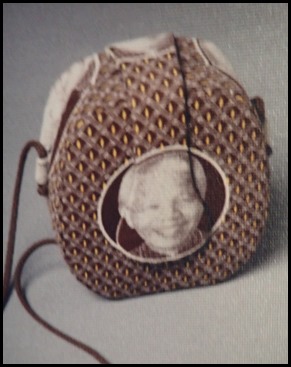 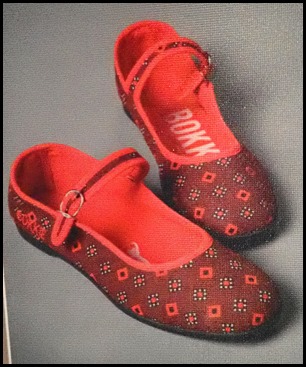 Bag designed by
Ruff Tung. Purchased in Johannesberg, Gauteng, 2005 Da Gama “Madiba
Range” fabric. Juliette Leeb-du Toit Collection, Iziko Soc Hist. Isishweshwe covered shoes with Bokkie label. Cape Town,
c.2010. (Both photographs by Carina Meyer).
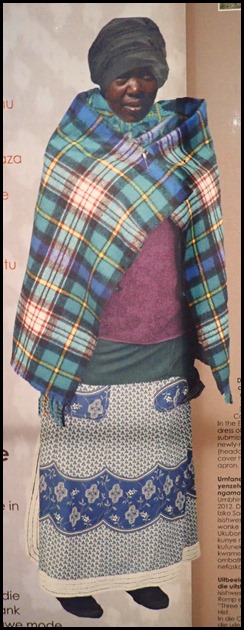 Depiction of
umakoti – a newly-married Xhosa woman – created for the exhibition The
isishweshwe story: material women? (Photograph: Carina Meyer). Skirt and apron
purchased in Idutywa, Eastern Cape, 2012. Da Gama “Three Cats” fabric, Juliette
Leeb-du Toit Collection, Iziko Soc Hist.
In the Eastern Cape isishweshwe is
traditonally worn as part of the dress of a new Xhosa bride or umakoti. To show
respect and submission (ukuhlonipha) to her husband and parents-in-law, a
newly-married Xhosa woman is expected to wear her ikhatshemiya (headcloth) low
over her forehead, keep her shoulders covered, cover her hips with a blanket and
wear isishweshwe skirt and apron.
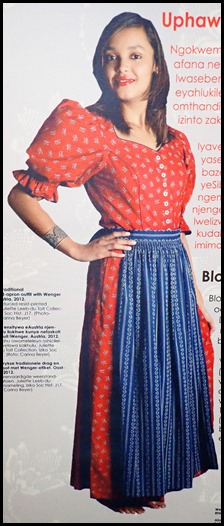 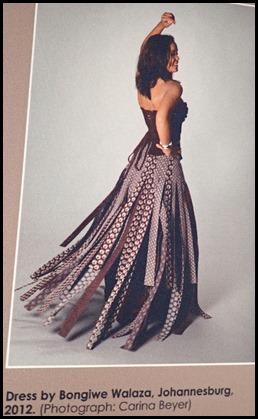 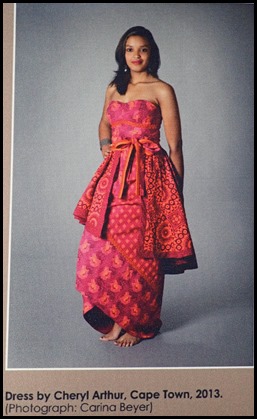 Austrian
traditional dress-and-apron outfit with Wenger label. Austria 2012.
Mass-produced resist-printed cotton. Juliette Leeb-du Toit Collection, Iziko Soc
Hist (Photograph:Carina Beyer) and two
designers.
A New Isishweshwe Fashion: The
potential of isishweshwe as a fashion fabric was exploited as early as the 1970s
by South African designers and entrepreneurs such as Jutta Faulds, Helen de
Leeuw and Penny le Roy. In post-Apartheid South Africa, the fabric has been
adopted for display on international circuits by internationally recognised
South African couturiers as Bongiwe Walaza, Amanda Laird-Cherry and Palesa
Mokubung.
Locally, people who design clothes
with isishweshwe include both seamstresses working from home and increasing
numbers of small fashion houses. Many West and East African dressmakers living
in South Africa also use the fabric in their designs.
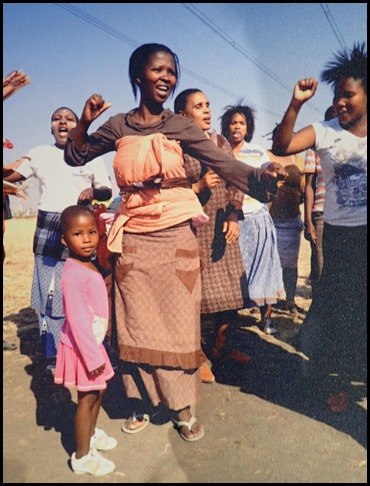 Women protesting
at Marikana the day after the 17th of August 2012 police shootings of
striking mineworkers. North West Province, 18th of August 2012. (Photograph:
Karin Labuschagne; image courtesy of Jacaranda FM). All the women depicted,
except the little girl, are wearing isishweshwe.
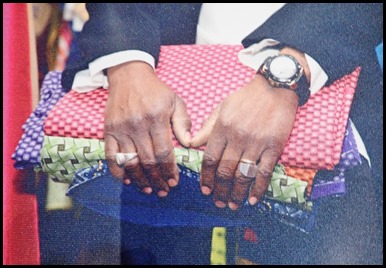 New colour ranges of isishweshwe tempt seamstresses,
designers and crafters alike to engage in creativity with the fabric.
(Photograph: Carina Beyer).
Isishweshwe for the future:
Users of isishweshwe adopt the fabric in ever-changing movements of creativity,
continually embracing new versions of African and South African identity.
However, it is rejected by some young city-born women as having rural and
oppressive associations. Besides its use as daily wear by women and increasingly
also by men, the cloth is imaginatively worn at both festive and informal
occasions, as traditional dress, to make a statement, or as an
accessory.
Isishweshwe’s highly
recognisable design aesthetic is being applied in new contexts, adorning objects
from book-covers to umbrellas. The Da Gama factory itself is printing its
traditional isishweshwe designs in non-traditional hues (such as pink and lime
green), and new patterns are regularly released.
Global trade competition is
threatening traditional isishweshwe markets, since the popularity of isishweshwe
has led to many cheaper imitations by local and Eastern producers. The original
discharge-print is still preferred by those who can afford
it.
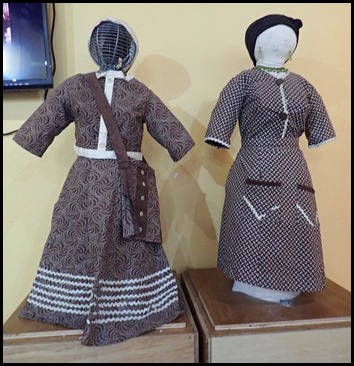 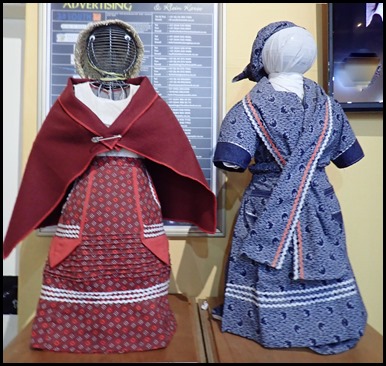 Today isishweshwe is embraced as a national fabric and costume in
many southern African countries. It holds a place of unique importance in the
history of culture, costume and fashion in South
Africa.
ALL IN ALL A FASCINATING PICTORIAL
STORY THROUGH THE YEARS
AN INTERESTING LOOK AT SOUTHERN AFRICAN
CULTURE |
